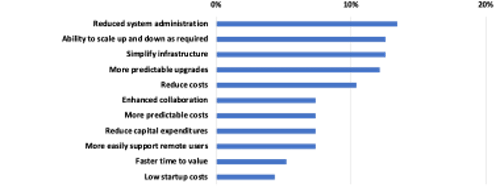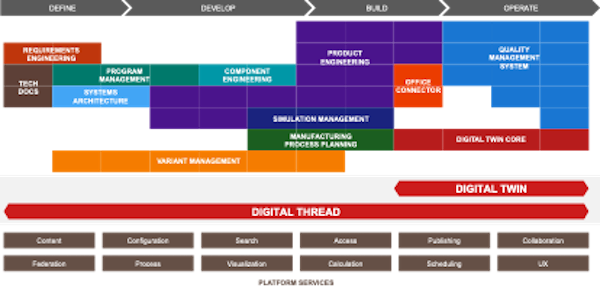Key takeaways:
- Recent CIMdata research on Cloud-SaaS PLM shows that two-thirds of respondents are considering a move to Cloud-based PLM solutions that they see offering them a wide variety of potential benefits.
- Over 40% of the survey respondents plan to phase in cloud-delivered PLM capabilities and integrate with on-premises solutions, and then phase out the on-premises solutions.
- Aras Enterprise SaaS is a PLM solution designed to leverage the scalability and accessibility of the cloud while connecting with legacy and on-premises solutions via its open, resilient integration approach.
- Aras Enterprise SaaS retains the differentiators appreciated by subscribers including extensive configurability, 100% compatibility with previous releases, and free upgrades on the customer’s schedule independent of how much configuration is done minimizing risks and minimizing potential compliance issues.
- Aras Enterprise SaaS adds containerization support to enable scalability and a complete DevOps environment to ensure low-code configurations are properly created, managed, and deployed.
Introduction
Software-as-a-Service (SaaS) is a means of software delivery in which all functionality is provided over the Internet or via a Virtual Private Network. The software provider hosts the software on infrastructure it owns or rents, and then bundles software, the infrastructure, and support (e.g., administration and upgrades services) as a service that is then licensed to customers via a subscription. Usually, customers can easily modify user numbers by paying for additional capacity or save money by reducing capacity.[1]
SaaS adoption has been rapidly growing in the enterprise domain for the past few years. Recent CIMdata research on Cloud-SaaS PLM shows that 66% of 269 respondents are considering a move to using cloud-based PLM solutions.[2] Figure 1 shows the percentage of respondents that identified potential benefits they expect to receive from SaaS-based solutions.
Most of the expected benefits relate to reducing cost, except for enhanced collaboration. CIMdata believes easier access to data will significantly improve business process speed especially as suppliers are given access.

Figure 1—Potential Cloud Benefits identified in 2021 CIMdata Cloud-SaaS PLM Research
(Source CIMdata Research)
Another interesting item captured in the survey was how the respondents expect SaaS solutions to be deployed. As companies move from on-premises to SaaS, the migration can be complex. The SaaS deployment approach ranges from a big bang to running cloud and on-premises permanently in parallel. Figure 2 shows the deployment plans of the respondents.
Figure 2—Anticipated Cloud/SaaS Deployment Approach
(Source CIMdata Research)
It is important to note that over 40% of the respondents plan to migrate and phase out their on-premises implementation over time, which aligns with CIMdata’s best practice of avoiding the risk of big bang while getting rid of process and system complexity caused by running the legacy solution in parallel for a long period of time.
Aras Enterprise SaaS
The Aras Enterprise SaaS product is a fully capable, business-ready SOC 2 / SOC 3 compliant SaaS PLM solution that has the full functionality of its on-premises counter-part. The December 2020 Version 12 release of Aras Innovator introduced a fully containerized solution that leverages cloud infrastructure for scalability, access, and management tools.
Aras Enterprise SaaS includes a DevOps environment to support its extensive configurability and the same tiered subscription licensing model as earlier releases where every user gets access to all software capabilities and training is included. The SaaS subscription includes access to all the server hardware and software, administrative support, and leverages cloud provider capabilities including telemetry to maximize performance and uptime.
For existing Aras customers, on-premises configurations can be moved directly to Aras Enterprise SaaS without modification. This follows Aras’ commitment protecting customer investment via the inclusion of upgrades as part of the subscription. Aras Enterprise SaaS offering continues the policy of upgrading customers no matter how much configuration was performed. Aras has proven the resiliency and upgradeability of their low-code platform over the years. Configurations[3] have always been upgradeable as part of the subscription.
Additionally, Aras has made great progress on their roadmap[4] over the years. While they’ve always focused on creating end-to-end solutions, their digital thread support enabled by pervasive native low-code capabilities is stronger than ever due to recent extensions to the platform in support of Systems Engineering (SE) and Digital Twin Core, as examples. Aras incorporated SysML to enhance its support of SE into their data model making integration of Model-Based SE authoring tools a straightforward configuration exercise. With their requirements engineering, system architecture and digital twin solutions it’s possible to link product information end-to-end within a single platform and data model. Figure 3 shows the current Aras solutions architecture.

Figure 3—Aras Enterprise SaaS Application Landscape
All Aras Innovator solutions, modules, and third-party products are supported by Aras’ Enterprise SaaS platform. The open APIs and data model enable data to be easily moved to other applications or even the enterprise open source on-premises release. There is no attempt to lock customers in. MCAD and ECAD integrations support a hybrid cloud configuration where the file vault has the option to be replicated to closer locations on the cloud to improve local desktop application performance. The recently acquired Medical Device and High Tech Electronics vertical solutions[5] are already available on the Aras Enterprise SaaS platform.
To create Aras Enterprise SaaS the development team rebuilt the web service engine to leverage Microsoft’s .NET Core services and the Docker standard so the platform can run within containers orchestrated with Kubernetes. This structure is commonly how cloud-based solutions leverage elasticity and keep operating costs down.
Managing the low-code applications requires tools. Since Aras customers extensively configure their implementations and Aras has and continues to support them, Aras chose to include a DevOps environment with the solution. This enables the Aras Enterprise SaaS support team to collaborate more easily with the customers’ developers and ensure that the developers use appropriate tools to develop and manage their configurations. Aras has embedded their best practices within the DevOps toolchain, as well as integrating it with Azure’s administration tools. The DevOps toolchain includes a test automation framework to support automated regression testing. Test automation frameworks (TAF) are a sophisticated and effective way to validate PLM solution configuration and customization, that have typically been an expensive add-on across the PLM industry. CIMdata is pleased to see the incorporation of DevOps with TAF as it eliminates the need for Aras customers to build and manage a complex environment.
Conclusion
Migration to the cloud is happening within the PLM industry. Anecdotally, cloud-first strategies are becoming common for CIMdata’s consulting clients, and our recent survey shows strong interest and progress toward Cloud-SaaS based PLM. The Aras Enterprise SaaS solution is Aras’ take on providing SaaS-based PLM to the market. Aras is known for its flexibility and configurability and will continue to offer no-cost upgrades to subscribers within the subscription context no matter how much configuration has been done. Being able to configure a solution as required and being able to upgrade without additional cost has been a long-time differentiator for Aras, and they’ve carried that powerful feature into their SaaS offering. Aras has continued to build out their product according to their publicly published roadmap, and while doing so they have added many useful applications over the past few years. Finally, by exposing the underlying services via open APIs and the low-code capability customers can easily configure custom solutions to meet business requirements without the risk and cost of solution provider lock-in. Companies looking for a SaaS-based PLM platform that supports extensive configuration to meet complex business requirements should look at Aras’ Enterprise SaaS platform.
[1] Research for this commentary was partially supported by Aras.
[2] https://www.cimdata.com/en/education/educational-webinars/research-on-cloud-saas-adoption-in-plm.
[3] Aras uses low code configurations to achieve a level of customization that used to require custom programming.
[4] https://www.aras.com/en/roadmap.
[5] https://www.cimdata.com/en/resources/complimentary-reports-research/commentaries/item/17550-aras-announces-merger-of-minerva-group-highlight.







